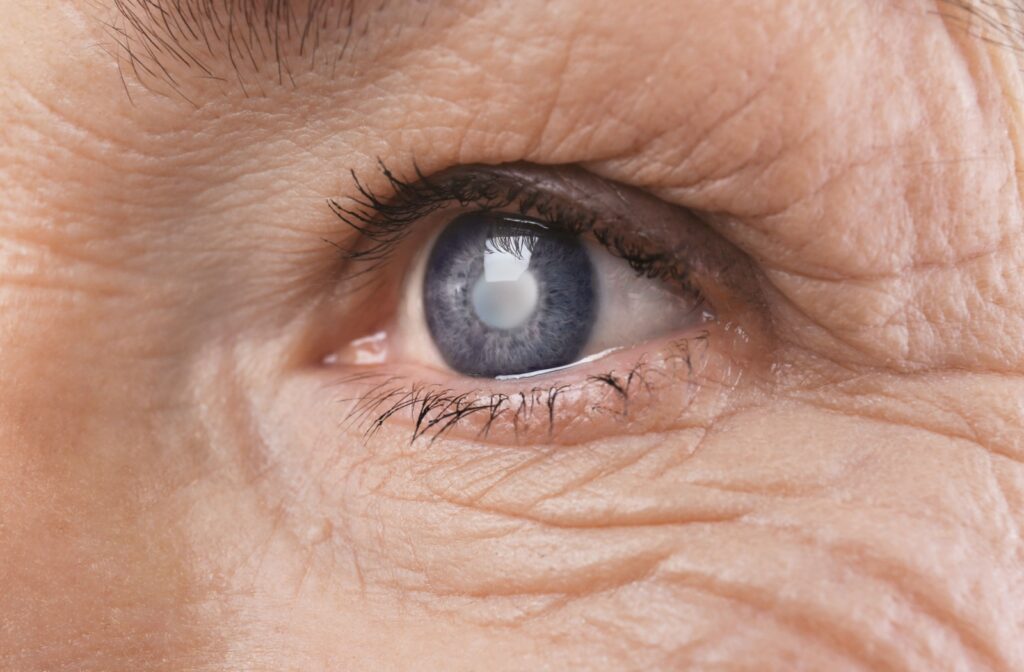Cataract surgery can restore clarity to your vision and improve your quality of life. However, like any surgical procedure, there are some potential risks involved. Cataract surgery is generally a smooth and safe procedure, however, every now and then, side effects may occur. Strabismus is one such possible side effect.
If you’ve noticed any changes in how your eyes work together after surgery, scheduling an eye appointment should be your next next step.
What Is Strabismus & How Does It Develop in Adults?
Strabismus, or misalignment of the eyes, occurs when the eyes do not properly align with each other while focusing on an object. Instead of working together, one eye may look straight ahead while the other points inward, outward, upward, or downward.
Although many people associate strabismus with children, it can also develop later in life, often due to injury, illness, or even underlying medical conditions like diabetes and thyroid problems. When it occurs in adults, strabismus can lead to symptoms like:
- Double vision
- Headaches
- Reduced depth perception
- Fatigue
Cataract Surgery & Strabismus
Cataract surgery involves removing the cloudy lens in your eye and replacing it with a clear artificial lens. While the procedure is relatively low-risk and has a high success rate, some people have reported strabismus developing after surgery. This raises the question: are the two connected?
How Common Is Strabismus After Cataract Surgery?
For the vast majority of patients, strabismus after cataract surgery is rare. Studies suggest that the incidence is relatively low, with the condition being considered an uncommon side effect. Most people who undergo cataract surgery experience marked improvements in their vision without any impact on the alignment of their eyes.
However, in some cases, reports of strabismus may reflect uncommon complications or be linked to other underlying eye-related issues that pre-date the surgery.
This makes it important to explore all elements contributing to post-surgery strabismus instead of pinpointing the surgery itself as the sole cause.
Potential Causes of Post-Surgery Strabismus
Here are a few potential causes of strabismus developing after cataract surgery.
Nerve Injury
Cranial nerves guide the muscles that control your eye movements. An injury to one of these nerves during cataract surgery is a very rare but possible cause of post-surgery eye misalignment.
Muscular Imbalance
Cataract surgery can sometimes disrupt the balance of extraocular muscles, which are responsible for moving your eyes. This imbalance may result in one eye not aligning properly with the other.
Pre-Existing Conditions
If you already had a minor or undiagnosed form of strabismus before surgery, the procedure might intensify this condition, causing more noticeable symptoms.
Anaesthesia Side Effects
Certain types of anaesthesia used during cataract surgery may affect the muscles or nerves temporarily. This can lead to short-term alignment issues, but these usually resolve on their own.
Changes in Vision After Lens Replacement
The brain relies on both eyes working together to create a single image. If your vision undergoes a major shift because of cataract surgery (e.g., improved vision in one eye but not the other), this can sometimes affect how your eyes coordinate movements.
What to Watch For

After any surgery, it’s always a good idea to monitor yourself for side effects or other complications. In the case of strabismus, here’s what you should look for:
- Double vision (seeing two images where there should be one)
- Eye strain or discomfort that doesn’t fade
- One eye appearing misaligned or “off-centre”
- Headaches when focusing on fine details
- Reduced depth perception or a feeling of imbalance
If you notice any of these signs, schedule a follow-up appointment.
Diagnosing Strabismus
If strabismus symptoms appear after cataract surgery, your doctor will run several tests to confirm the diagnosis. These may include:
- Eye Alignment Tests to assess how well your eyes coordinate.
- Ocular Muscle Function Testing to check for muscle weakness or imbalance.
- Medical History Review to rule out underlying causes like neurological conditions.
Treatment Options
If you are diagnosed with strabismus, don’t worry—there are several treatment options available. These include:
- Prism Glasses: Special glasses fitted with prism lenses can help correct double vision caused by eye misalignment.
- Eye Exercises: Certain exercises can strengthen your eye muscles and improve coordination over time.
- Surgery for Severe Cases: If other treatments are not effective, surgery to adjust the alignment of your eye muscles may be recommended.
Staying Proactive About Your Vision Health
Cataract surgery offers a benefit for most patients. While the possibility of strabismus after surgery exists, it’s rare and often manageable with proper care and guidance. If you’re experiencing any unusual symptoms after cataract surgery, book an appointment with Brighton Eyecare.









